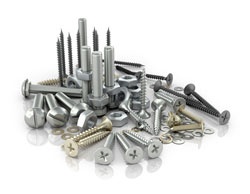
We find fasteners fascinating. There are several categories and then a huge depth and breadth of options available within them. There is an ideal fastener for every job. Are you using the right one for your materials and tasks? Check out this simple guide to the wide world of fasteners.
Staples
A staple is a two-pronged fastener, generally steel or aluminum, used to bring two materials together. They can range from narrow to wide, fine wire to heavy gauge, and can be coated or treated based on intended use. They come in strips and require a staple gun for installation.
Staples can be used for roofing installs, furniture and cabinet framing, floor underlayment, siding, fencing, crating, trim and insulation installation.
Nails
Nails are the most common fastener. They are long with a sharp point and flat head, designed for impact. They are primarily used to install things quickly and easily into wood. They are intended to be driven into wood, but not to be removed. They are available in several metals and finishes, many are galvanized, which means coated with zinc to prevent rust. They come in a variety of head types created for different uses. They are installed individually or collated into strips for use in a nail gun. They are generally the cheapest and most readily available construction fastener.
Nails can be used for wood construction, roofing, securing wood to stone or brick, drywall, siding, carpentry, and carpet installation.
Brads and Pins
Brads and pins are considered a finishing nail. A Brad is a very thin nail with a small flat head. Pins are very thin nails with no head at all. They both come in sheets and require a specialized gun to install.
They are both used for delicate finish work when you don’t want your fasteners to be visible. They are used in trim, furniture construction, and some pallet construction.
Screws
Screws are the most versatile fastener. They are made from a variety of metals, and come in a range of finishes and head types. They are threaded down the shaft to allow the strongest grip on the material. They are designed so they can be removed if needed. The head comes in a range of drive styles, from traditional slot and Philips head to hex or star drive, which are suited for different purposes based on the material you’re driving in to and the tool you’re using. They can be collated or individual.
Screws can be used for most jobs that nails can, but they have slightly stronger holding power and you are able to quickly and easily back them out. They are popular in decking, drywall, steps, and furniture construction – all which may require backing out for adjustments. They do tend to cost more than nails however, which is why people don’t just always use screws.
Combination Fasteners
Combination fasteners, like SCRAIL® from The BECK Fastener Group ®, combine the best of both the nail and the screw. SCRAIL® collated fasteners are incredibly versatile fasteners that can be driven with a pneumatic nailer at a rate twice as fast as collated screws and eight times faster than bulk screws. They offer dramatically increased holding power versus nails, while gaining the added benefit of easy adjustment and quick removal.
Combination fasteners can be used for any job that a screw or nail can be used for.
When taking on any construction project, be sure you are using the right fastener and the right tools. FASCO America ® offers a full line of high-quality fasteners and pneumatic tools to help you get your job done right the first time, fast.
.svg.png)

